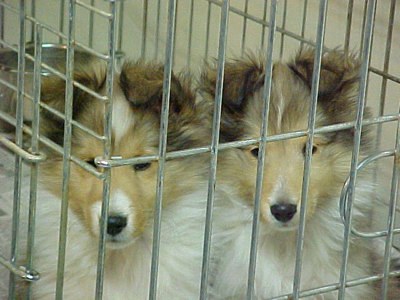
A Guide for raising Your Puppy
A new puppy is furry, cuddly, and full of joy.Being a pet-owner is a lot of fun,but it is also a big responsibility.
In spite of negative first reactions, many dog owners, expert authorities and veterinarians recommend dog crates as the best way to raise a puppy. The most important benefit that accrues to the pet owner who utilizes crate training is the control of the puppy when it is alone at home. When puppies are left alone and allowed to roam too large an area, they become anxious, lonely and bored. By using a pet crate the owner creates positive behavioral patterns which enable the relationship between the pet and his owner to develop and grow. Consider, too, these additional benefits:
* The virtual elimination of "housetraining" problems and the attendant "accidents" in the house.
* The savings in dollars in costs to repair or replace damaged household items.
* An assurance that the puppy will develop good habits.
* Eliminating the likelihood of having to give up a pet because of not being able to cope with its behavioral problems.
The dog crate is a sanctuary for your pet. It is your pet's well protected home. "Not somuch that it (your pet) cannot get out, but that humans cannot get in:' according to a recent release from a major pet food manufacturer. The pet crate is comfortable to your puppy because, like his wild ancestors, he instinctively seeks the safety and security of a "den:' The fact that we may see the crate as a very limited space,or very confining, is only a human view. The dog finds a crate a secure haven, more secure than the confusing and sometimes frightening outside world. According to a recent survey, the majority of dog owners were initially opposed to crates but were later typically supportive and enthusiastic -- "He loves his crate...I don't believe it." "I'd never raise another dog without a crate" "It saved my sanity." "lt makes traveling with a dog a delight." "Thanks to the crate, our puppy is always a pleasure and never a problem."
Ten Steps
A recommended procedure to prevent problems is based on several canine tendencies. These are the pup's preference to bed down with or in the presence of, others; to bed down in a sheltered, den-like atmosphere; and to learn through association.
1. Acquire a dog crate, either wire or a standard 'airline' type. The crate should be large enough for an adult dog to stand and turn around unimpeded, yet not so large that the dog has room to fit in there several times. A wire type crate will give more ventilation and so the dog can see out, but conversely an airline type is warmer and usually more adaptable to traveling with your dog. Either kind works fine and both will accomplish the same thing.
2. Assemble the crate and place it in the kitchen or bedroom. This is recommended because your dog wants association with others.
3. Introduce the pup to the crate by placing several treats in and around it. Also, feed the pup several meals inside the crate.
4. Well before bedtime, place the pup in the crate and offer a treat. Close and lock the gate.
5. Leave the room, but remain just outside in order to audit the pup's behavior.
6. At the first sign of any separation responses (such as barking or howling), intervene with a sharply raised voice. The idea is that the pup associates its behavior with the startling raised voice. Some pups will not respond to a raised voice, but most will respond to the sounds of a shaker can (a coffee can with a few coins) or a newspaper slapped sharply against the door.
7. Usually the pup settles quietly in the crate after three to eight attempts at emotional responses. After the puppy is quiet, keep it inside for about 10 minutes. Do not praise or pet the pup im- mediately after releasing it. This can reinforce the desirability of leaving the crate.
8. After an interval of 30-45 minutes, repeat the procedure. Extend the pups quiet time in the crate to about 30 minutes.
9. While the pup is inside the crate, provide fresh water (an attachable 'coop' cup is usually preferable) and one chewable toy. Also, any collars or leads should be removed to prevent entanglement.
10. Gradually extend your absent periods, and, in a short time, you can be gone for several hours.
By the time bedtime arrives, the pup has associated being quiet with being inside the crate. Also, the effects of separation are lessened because of the crate being ina bedroom where a family member sleeps. Be advised that usually after waking the pup will eliminate. It will probably whine or bark, since dogs tend to avoid eliminating in their bedding areas. The pup can then be taken outside to eliminate. This will reinforce your housebreaking steps by teaching that it should waiting to go outside before eliminating.
Dog Crates...Cage or Home?
Originally Posted 2009/Updated January 2021